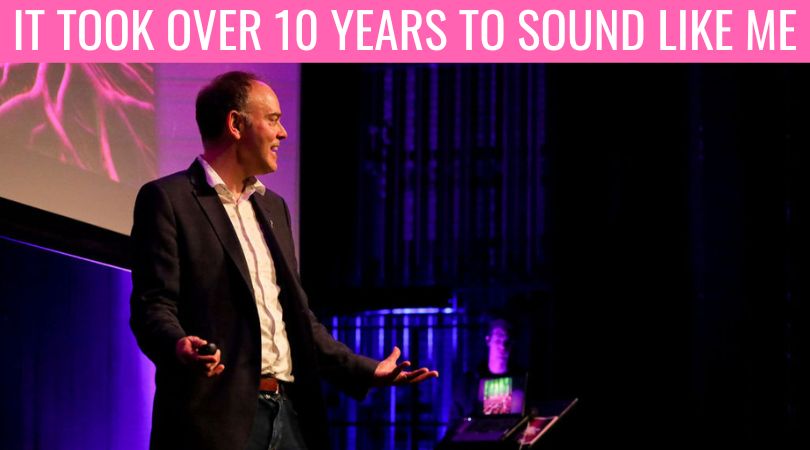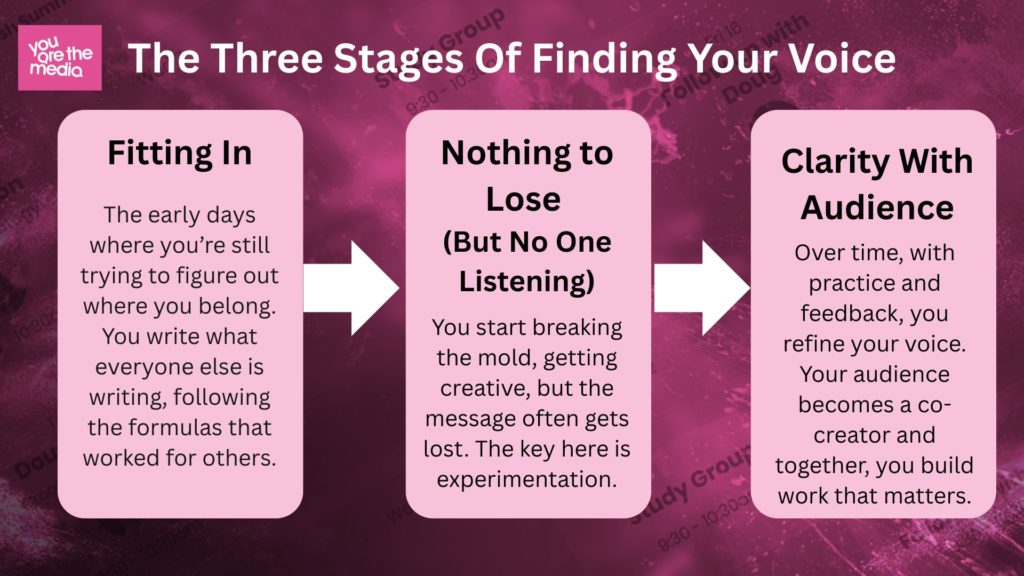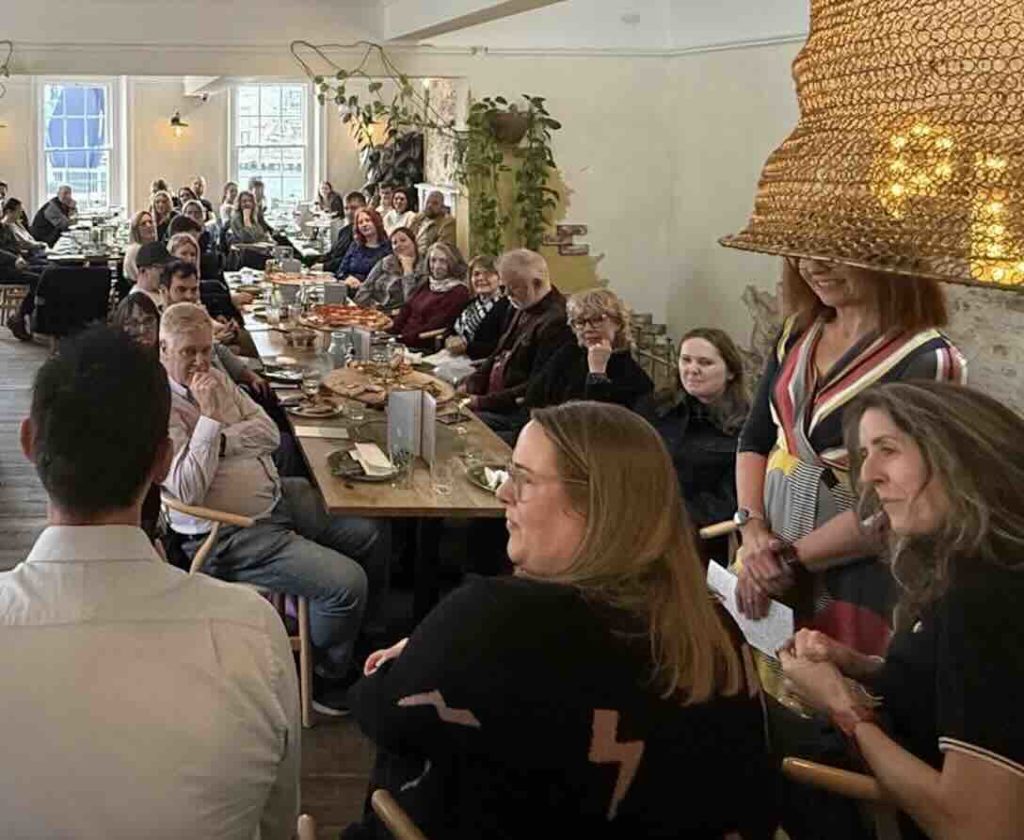Let’s learn and create together!
Book your placeYou Don’t Find Your Voice. You Build It

When you find a way to express your ideas in a way that feels true to you and connects with others, it transforms everything.
It’s when you stop copying other people, cease trying to be clever, steer clear of bandwagons and you start saying what matters, in your way.
However, to get there doesn’t happen as soon as you start, but that’s ok.
Finding your voice takes time. From my own experience that has been shaped in three stages. This journey not only reflects of me, it also recognises where you may be in your own efforts.
My Own Path
In the early days of You Are The Media, I sounded like everyone else. Then I aimed to sound like no one else. It took years, and a community, to finally finally express my true self.
A lot of what I do requires time. If I had the rulebook or followed someone else, maybe I’d hit milestones a lot quicker. However, it has taken me over 10 years to find a place that feels like it’s truly working.
When I look back through the You Are The Media blog, that started in 2013, I can clearly see three stages in how my voice developed.
If you’re creating regularly, whether it’s for your newsletter, YouTube, podcast, LinkedIn, or you deliver events, your voice is the bridge between what you make and how others feel about it.
Initially, we all copy others. Then we start to react. Eventually, if we stick at it long enough, something better happens: we find clarity, not just in what we say, but in why we say it and who it’s for.
Let me show you what these three stages looked like for me and how they can help you build a voice that has its own place today, where you feel comfortable.

Stage 1: Fitting In (2013–2014)
When I began the YATM blog, I was publishing regularly, but I wasn’t doing anything different, I was just blending in.
When I began, it had a marketing focus, but everything was generic. My structure resembled what every other agency or small business blog was doing at the time. I was trying my hardest to sound knowledgeable, but I lacked my own proof to back it up.
The articles weren’t wrong, but they were dull and they were not me.
Let me share with you some bland examples that I put my hand up and say, this is my work.
- How Can You Grow Your Business?
- Why Is It Important To Build And Grow Your Database?
- How To Build An Effective Brand
What I shared was surface level advice in the hope to gain attention and people would see my work as worthy to enquire. It didn’t happen.
Perhaps you find yourself creating work that simply fits in with what’s already out there? That’s ok. What I’ve realised is that the problem isn’t the lack of information, it was it lacked permission. I didn’t feel that I could bring in my own experiences, humour or quirks into the world. My role was to fit in.
I conformed. I wrote for what my industry expected and assumed what an audience would want, not for the people I knew.
If you find yourself in this stage, it’s a necessary part of the process. It’s where you learn how to show up, you share and you think in frameworks that are relatable to your industry.
I had to write like everyone else, before I figured out how to write like myself.
Stage 2: Nothing to Lose (But No One Listening) (2015–2019)
When you realise your work doesn’t sound any different, you start to add personality and find ways to bring you to the front.
I began to feel frustrated with the monotony of it all. I didn’t want to write what was expected. I wanted to have fun with my writing. I wanted to express myself.
The result? I went rogue.
I became reckless in my writing. I tried to be too clever. I overused metaphors, got carried away with “creative” analogies, and often wrote in a tone that, while amusing to me, it missed the mark with readers and those who subscribed to the weekly newsletter.
Here are two of best examples to show you what I mean:
I tried to be bold, as a person with celiac disease. It’s unexpected. It’s also… a little bizarre. The analogy is strained. The humour gets in the way of the point. The thing is I had a small audience to disappoint, and I was finding my edge.
I was deep in the “nothing to lose” phase, pushing back against content marketing conventions with bold conviction, but the delivery is tangled. It lacks grounding and clarity, so people are unsure of the takeaway. It’s where my voice was in flux: determined to stand out, but still searching for the structure and simplicity that I wanted to have.
By adding your personality into your work is a vital stage.
When there’s no one to impress, you’re free to experiment. Voice only develops through challenges. When not many people are watching, you can afford to say things that flop. It started to give me a place to see what resonates (and what doesn’t).
This was also the beginning of me taking shape — not just as a marketer, but as someone with a point of view, a personality, and a belief system. I didn’t yet have traction, but I was beginning to build trust in myself, regardless of how uncertain my path seemed.
Stage 3: Clarity With Others (2020–Today)
The more consistently I showed up, the more people started to show up with me.
I started to get to know the people around me. Lunch Clubs brought people together and an annual event, helped people see my intentions.
Around 2022, the voice of You Are The Media settled into a rhythm. It became clear, confident, and most importantly, collaborative.
I no longer had to shout to be heard. I didn’t have to rely on overused frameworks or gimmicky hooks. I’d built a space with people alongside me who understood the rhythm, humour, and intent behind the work. I wrote with them in mind.
I started to know who I was creating for an who it wasn’t intended for. My work was for people who wanted to be self sufficient to know how to create on their terms. It was also for people who believed that interdependence and being around others is what can help to amplify our own efforts. It was for people who are fuelled by creativity, community, experimentation and also togetherness.
It’s at this stage where my ideas started leading to shared experiences. Creator Day became a way for people to know they were part of a space much bigger than themselves. Lunch Clubs started to become led by other people from the community. This meant I could document the process, share the change and became more about tools for thinking when it comes to building your own space and not be wholly dependent on an algorithm.
Here are two examples of how my voice evolved to match my audience’s needs:
This piece is about belonging before broadcasting. It focuses on the need to be seen, heard, and connected. It helped me frame YATM as a place where people find each other. It’s not about pushing a message, it’s holding space and saying to people, ‘there’s room for you here.’ Over time I realise that people shouldn’t just consume what is shared; they see themselves in it.
This was about openly reflecting on past discomforts, comparison traps, and identity shifts, but it’s all in service to a clear message. You don’t have to shape-shift to be accepted. This is about making a space for others feel a part of where we don’t have to fit in. It transforms YATM into a mirror, not just where I stated with a megaphone.
The reason I wanted to share is that it reflects how, the longer you keep going, the more clarity you gain, not just in terms of advice but to tune your narrative to the needs and expectations of the YATM community. It’s about meeting people where they are, rather than creating a platform where you assume you know better than they do.
The dialogue is no longer one-sided; it’s an ongoing conversation. I know the role I serve for others today,
Let’s Round-Up
Finding your voice is a process of trial and error, of experimenting, of failing and adjusting, and ultimately, of connecting with people in ways that feel true.
You can’t find the answer in a book or ChatGPT, you just have to step into the ring.
Let me summarise the three stages:
1. Fitting In: The early days where you’re still trying to figure out where you belong. You write what everyone else is writing, following the formulas that worked for others.
2. Nothing to Lose (But No One Listening): You start breaking the mold, getting creative, but the message often gets lost. The key here is experimentation.
3. Clarity With an Audience: Over time, with practice and feedback from others, you refine your voice. Your audience becomes a co-creator of the message, and together, you build something that matters.
AI and automation have now infiltrated every aspect of content creation. What makes your voice unique is that it can never be replicated by algorithms. People want to connect with someone they know and trust and feel familiar with.
Finding your voice isn’t about being perfect, it’s about being present and in conversation with your audience. Continue to show up. Keep experimenting. And above all, you have to keep being you.
Build Your Community
A brand new programme from Mark Masters for businesses wanting to make that next growth step.
Find out moreYATM Club
Where non-conformist business owners come to work, learn and make friends. Click here

